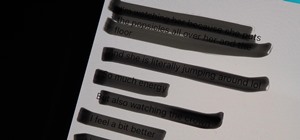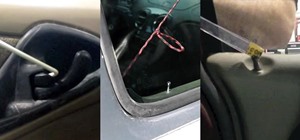All you science and astronomy nuts out there, pay attention, this detailed video tutorial series will tell you everything you need to know about using the Meade EXT-80-TC Telescope to ogle the universe. Meade’s new, larger 80mm diameter ETX-80-TC delivers more light-gathering ...more
On June 23, National Geographic will begin welcoming visitors to the world's first outdoor planetarium in Quebec, Canada, where an augmented reality experience overlaid on the night sky will replace the projection systems of traditional facilities. Visitors at Québec's Observ ...more
When Cerek mentioned astronomy-inspired artwork in his Astronomy World introduction post, I immediately thought of Russell Crotty. Crotty is a California artist who creates beautiful sculptures and drawings inspired by astronomy, landscape, and surfing. An enthusiastic amateu ...more
All you science and astronomy nuts out there, pay attention, this detailed video tutorial series will tell you everything you need to know about using the Meade AZ Series Telescope to ogle the universe. Whether used as casual telescopes for astronomy or as high resolution spo ...more
The Federal Communications Commission (FCC) has cleared a path for Google to move forward with hand-tracking technology that could pose a major threat to Leap Motion. In an order issued on Monday, the FCC granted Google permission to run its Project Soli, a sensor that can de ...more
Apparently a little amateur astronomy can go a long way. On March 21, 2009, Ralf Vandebergh, sitting in his backyard, pointed his 10 inch telescope at the sky and "saw a few bright pixels appear precisely where the work was going on at exactly the moment it was being conducted ...more
One of the things I consistently notice amongst fellow internet users is that many people don't know how to properly search for stuff. Google may have served you well in the past, but I'm going to share a few little tricks with you to help make your search results even spiffie ...more
Here, you'll see the use of red light to preserve your night vision, in Amateur Astronomy for Beginners - Red Light. Bright lights could make it harder for you to see those stars, so use red light, because the rods in your eyes can take it better.
This science video shows how to estimate the diameter of the Sun, including step-by-step instructions for constructing the equipment needed and an overview of the geometry of similar triangles. If you like space and science experiments, you can't miss this one. This video tut ...more
Chris Haney, one of the creators of the Trivial Pursuit board game, died Monday, May 31st. But what does Chris Haney and Trivial Pursuit have to do with SCRABBLE? Well, SCRABBLE and Trivial Pursuit are both owned by Hasbro, but that's not the interesting part. Chris Haney a ...more
Keep your stargazing sights and new experiences logged in a journal. Watch Amateur Astronomy for Beginners - The Astronomical Journal. A few suggestions on what to write: 1) Date and time (local time and universal time). 2) Weather and sky conditions (is it windy or cloudy? ...more
All you science and astronomy nuts out there, pay attention, this detailed video tutorial series will tell you everything you need to know about using the Meade EXT Premier Telescope to ogle the universe. Just because a star may be millions of years old, doesn't mean it shoul ...more
This video gives you some advice for beginning your hobby in amateur astronomy and how to use a planisphere and a pair of binoculars in this Amateur Astronomy for Beginners - Planisphere and Binoculars. Always remember that the most important tools are your eyes. Go out under ...more
There isn't much going on this week, but be sure to try viewing the Spica-moon conjunction. It will be hard to view with the full moon, but it will be spectacular if you can snag a peak. April 6: Spica-moon Conjunction, full moon April 7: Io transit; moon at perigee (358,313 ...more
If you're into entomology, then you probably recognize the name E.L. Trouvelot. After all, he was the person responsible for the outbreak of invasive gypsy moths in North America, which are now one of the most destructive foliage-eating pests in the United States. After leavi ...more
See how to align the finderscope with the primary optics in this brief tutorial on your telescope. Watch this Amateur Astronomy for Beginners - Telescope Finderscopes.
There wouldn't be any chaos in the world without Benoit Mandelbort— chaos theory, that is. Mandelbrot, who just passed away at the age of 85, pioneered fractal geometry and greatly influenced chaos theory. He spent most of his life working in physics, biology and astronomy, an ...more
On August 21, a total solar eclipse will be able to be seen across the country for the first time since June 8, 1918, and it's going to be incredible. Retired NASA astrophysicist Fred Espenak spoke to ABC News about what to expect and said: It's unlike any other experience yo ...more
From Astronomy Picture of the Day, Milky Way Over Abandoned Kilns by Tom McEwan. McEwan shot some historic kilns in rural Nevada, stitching together a panoramic "digital conglomerate of five separate images taken in early June from the same location. Visible above the unusual ...more
Later today, an asteroid the size of a city block (about 3,000 feet wide) called 2002 AM31 will fly by the Earth. It will still be about 3.2 million miles away, so there's nothing to be worried about, but you can watch it make its journey in real-time online. 2000 AM31 now, as ...more
Learn the basic information on eyepieces for your telescope, so you can gaze at the stars correctly in Amateur Astronomy for Beginners - Eyepieces. Learn the difference between low, medium, and high power eyepieces.
Telescopes help amateur astronomers view the stars and see the universe. Learn how to use and care for a telescope from an observatory director in this free astronomy video. Part 1 of 15 - How to Use telescopes. Use telescopes - Part 2 of 15. Click through to watch this video ...more
Astronomy editor David J. Eicher shares treasures from his personal meteorite collection and gives advice on starting your own.
The recent report of the ubiquity of extrasolar planets coupled with the fact that it bodes well for searches for life friendly Earth twins, brought me back to my reading of Carl Sagan's 1966 Intelligent Life In The Universe and later article in Sky & Telescope where he came u ...more
Since the Geminid Meteor shower is intensifying more every year, grab your binoculars and lay down in a field to enjoy the show! If you are going to observe one day, do it on the peak: December 14th. The shower is caused by Palladian asteroid 3200 Phaethon. This, along with t ...more
This week's AON might be a little short, but finally, the Garradd comet's peak has come! I picked the Garradd comet to follow because it's a bright and easy-to-follow comet. Be sure to observe it! If you need help finding it, you can find more information here. Until March: T ...more
Measuring the distance from the Earth to the moon doesn't require NASA equipment. The ancient Greeks did it, which means 2,000 years later, you can do it, too. It works something like this: "Many people have held up a round object and let it block the Sun. Most of the time, ...more
Hubble Catches Star Consuming Its Planet Hubble Telescope has discovered a planet-eating star. According to NASA, the star is currently consuming the planet Wasp-12b. But don't worry about missing this phenemona. Scientists say the star could take 10 million years to swal ...more





















































